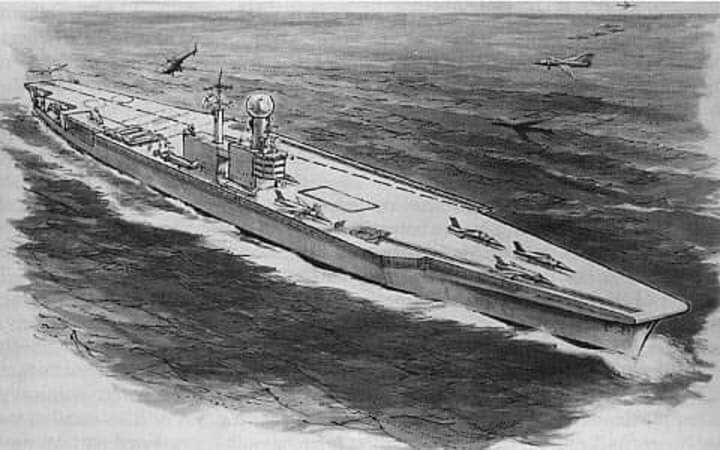The RN werent really angling for the F-111B as such (tto big, and expensive) they just knew they needed to be able to cross deck with the USN and thus their next generation aircraft.
Possibly, but there was barely six months between the F-111B flying and the design changes, which seems a rather quick turnaround of design, especially when the trade-offs were £45,000 additional cost, 15 tons additional weight and loss of accommodation space for 20 crew. Was all that worth it to cross-deck the F-111B, even assuming their Lordships/MoD felt confident that McNamara's folly would be a roaring success.
The Navy had been stung by home products (Attacker, Scimitar, Sea Vixen) partly due to their own muddled thinking and partly due to design flaws. OR.346 had resulted in nothing and OR.356 had become a V/STOL and faced with compromise - if not outright hubris from industry - they plumped for the Phantom (notably at the same time they chose Chinook over WG.1 and would soon choose Sea King). Even if Marcel Dassault doesn't murder AFVG in the cradle, a torturous acrimonious development programme plus the fact that the Marine Nationale were looking at lighter fighters for their smaller carrier decks would have meant the same kind of compromises that they were forced into for P.1154. At that point (say late 68-1969ish) the Admiralty might have put the knife in and said "AFVG is no bloody use we want F-111B".
Of course by then the F-111B is dead, but its a sure bet that the USN worries over weight would have scared their Lordships, 70,000lb was very much a theoretical limit and as we can see, the catapults and arrester gear were not fully rated up to that spec. So F-111B was probably never a practical choice in that regard.
But we must return to the F-4K. If CVA-01 lives is less of that 170 order is trimmed off? Here were need to consider whether a 1966 cutback would limit the new CVA-01 to just one hull. The 1968 withdrawal from EoS by the early 1970s would almost certainly kill CVA-02. It seems unlikely the full 170 would be delivered.
The intention for the reduced 48+7 order was to form a pair of front-line squadrons (12 a/c each) for the two remaining modernised fleet carriers. The training unit would have the remainder plus a reserve pool. The 1968 cuts removed
Eagle's modernisation and the 7 options were never taken up.
Now in this scenario CVA-01 would replace
Eagle and so we still have two flattops and no need for more than 48. If CVA-02 is ordered to replace A
rk Royal circa 1975-77 that still leaves us with two carriers long term.
Even if Healy is somehow convinced not to abandon EoS or decides a carrier strike fleet is the best option for NATO and keeps on
Ark Royal and builds CVA-01 and CVA-02 its unlikely all would be operational at once and 2 Phantom squadrons could rotate on the commissioned vessels. It's really hard to justify more than 50 Phantoms and certainly 170 would have been an embarrassment of riches even for three carriers, 70-75 seems more realistic even for a maximum 3 carrier fleet to get by on.
So returning to F-14....
How many would we need? No more than 48 for like-for-like F-4K replacement. But that assumes that there are two F-14 capable carriers. If CVA-02 is not built it feels highly unlikely that a split-fighter force is likely, 18-20 F-14A would be a token force hardly worth the logistical and training hassles and the F-4Ks would still be young.
If CVA-02 is built then an F-4K handover to the RAF is possible around 1976-77 for re-equipping with F-14A. Given the engine issues etc. I'm not sure its a wise buy though. The dates probably begin to align with early RAF F-14A thoughts for ADV though, so its possible a joint order might succeed and thus MRCA remains a strike platform.
Equally possible is a naval MRCA version as outlined above, which is tempting.
But equally its impossible to ignore that F-4K is still relatively new, 892 NAS didn't go aboard
Ark Royal until 1970, Queen Elizabeth commissions in 1973-74 (74 perhaps more likely given shipyard constraints)and by then all 48 FG.1 would be in service. So with brand-new aircraft any re-equipment during the 70s feels highly unlikely, especially with a high-end F-14A solution and a Buccaneer replacement might feel more pressing given all the fleet would be 10 years old by the mid-70s.
The RN might go for a single-type swing-role fleet for the 1980s, better for logistics, training and costs. This could possibly be MRCAN to enter service around 1980-81. F-14A has no real air-to-ground role at this time so would seem unlikely to fulfil a single-type airwing.
Of course by 1977-79 there is new multirole contender, one being assessed very strongly for AST.396, the F-18.... with potentially huge implications for the entire British aviation industry.
Or we get ECF-N with possibly France atoning for scuppering AFVG back in the summer of love and staying on board or a bespoke expensive Sea Typhoon which is ready in 2000 just as CVA-01 reaches the breaker's yard in Turkey.... to be replaced by a new CVAF (AF = Attack Future) HMS
Queen Elizabeth. No joint RAF-RN joint force F-35Bs for the 2010s.
Mind you, RN F-14A operations over the Falklands would probably boost the Tomcat's 1980s pop star popularity beyond all reason, becoming so much of a poster child that all aviation geeks forget the Phantom entirely!

